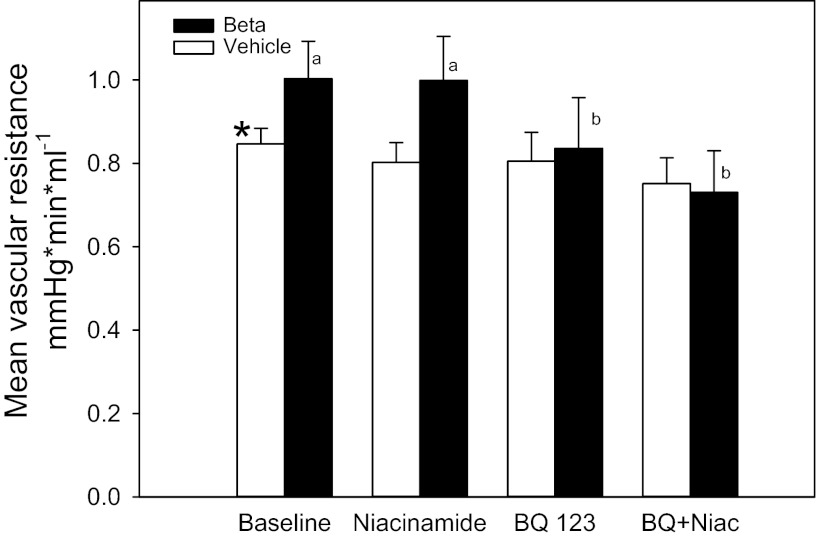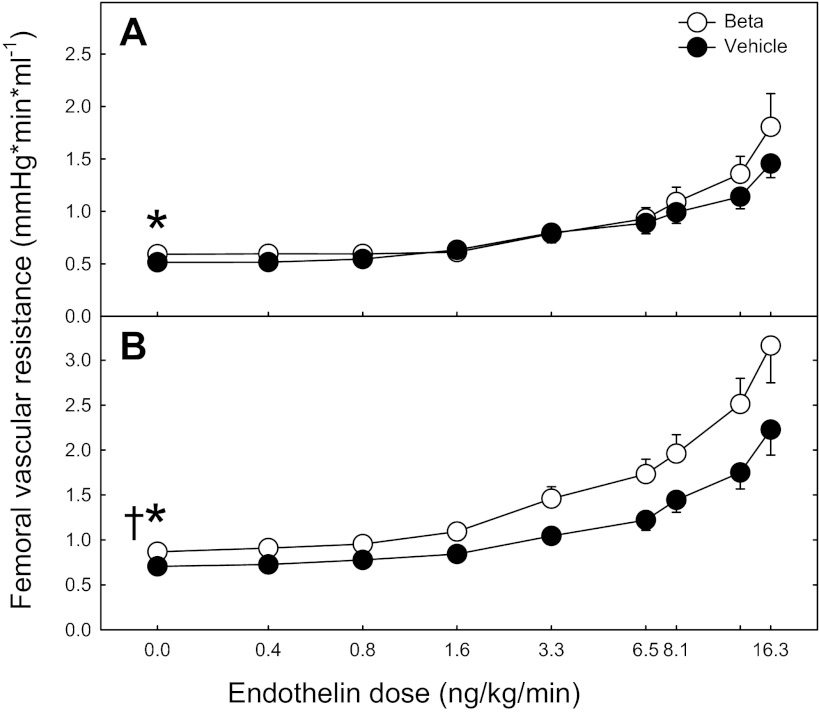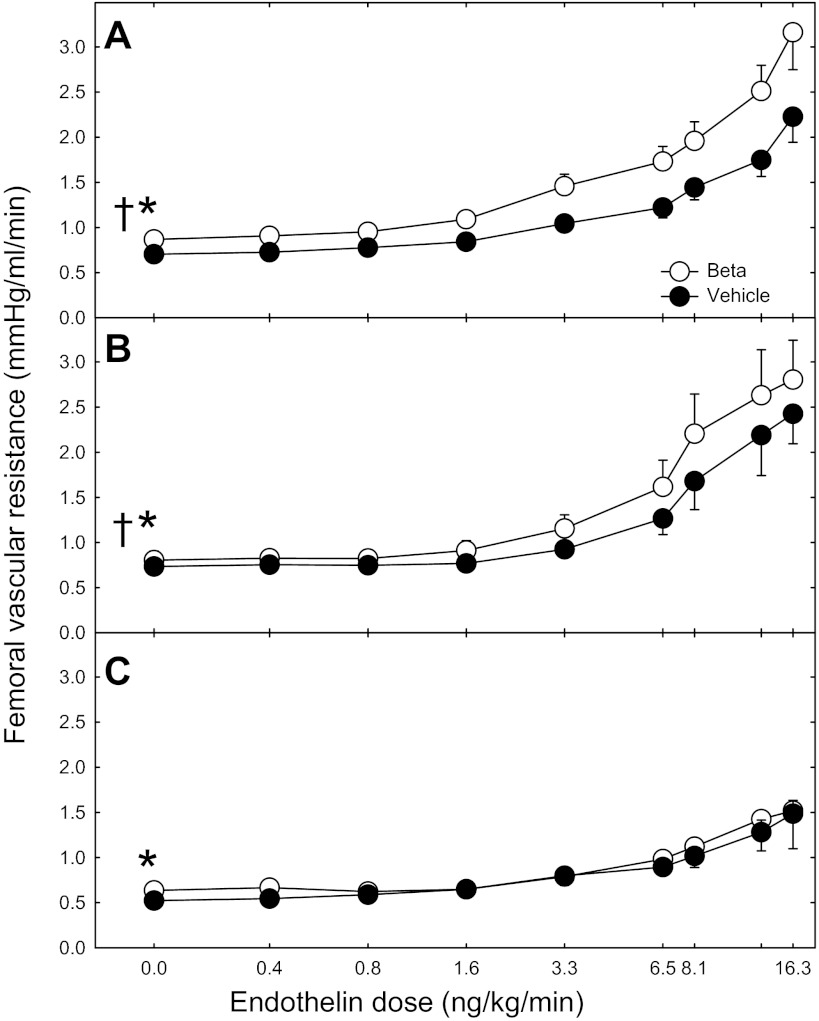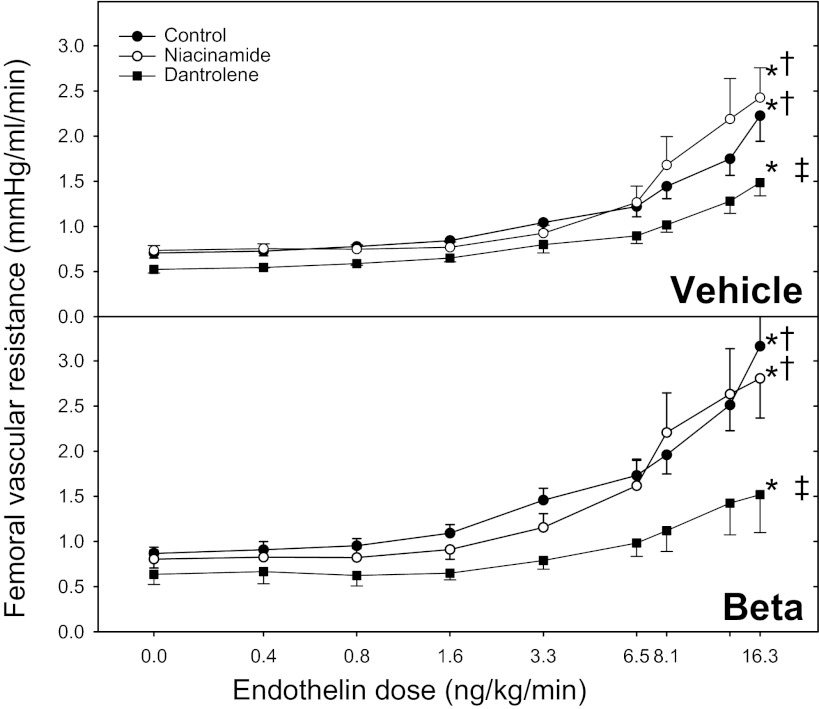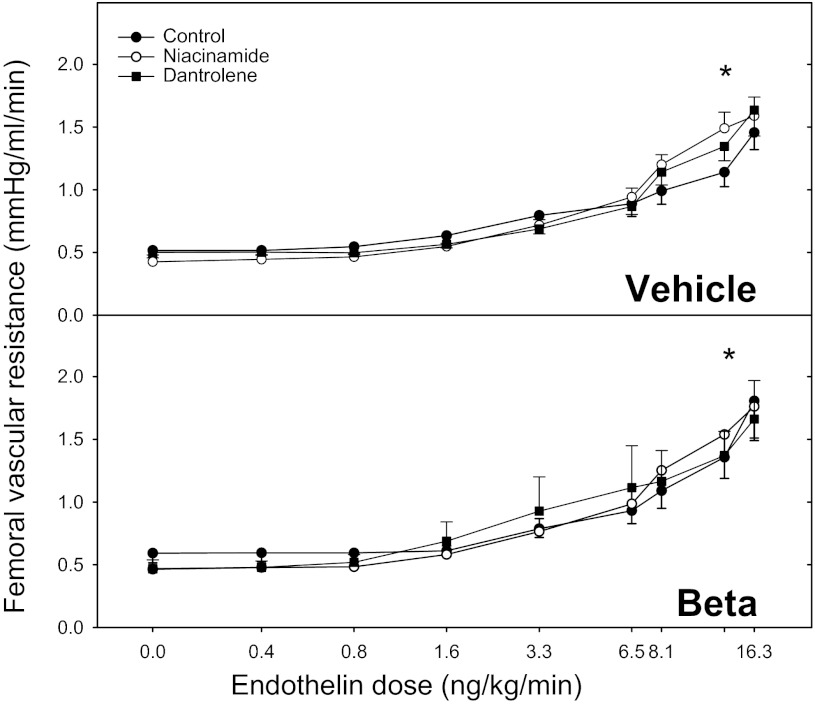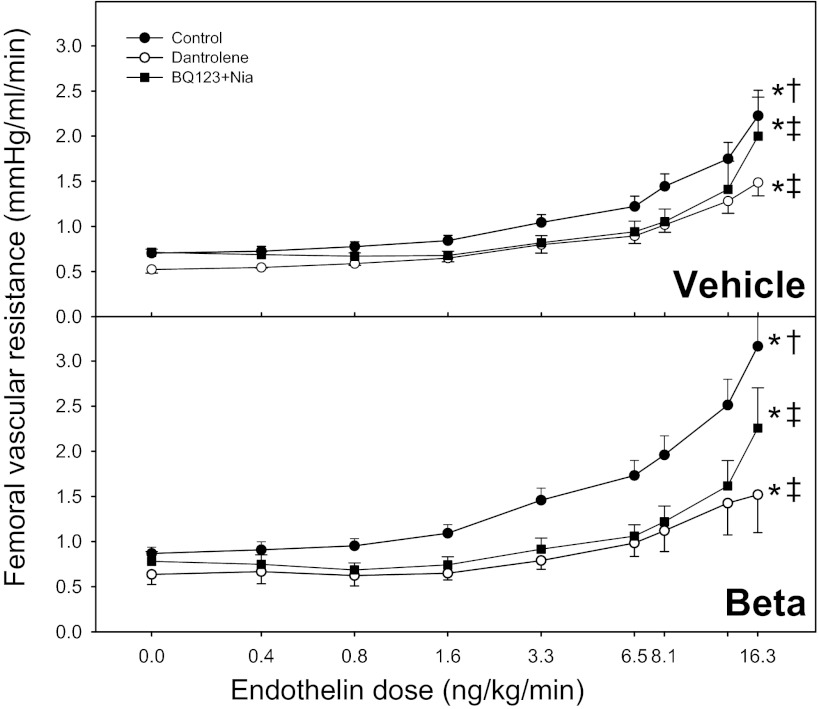Abstract
Antenatal steroid administration is associated with multiple cardiometabolic alterations, including hypertension; however, the mechanisms underlying this phenomenon are unclear. The aim of the present study was to ascertain, in vivo, the contribution of the endothelin system to the development of hypertension in the adult offspring and the signaling pathway involved. Pregnant sheep were treated with two doses of betamethasone (n = 23) or vehicle (n = 22) at 80 days (∼0.55) gestation and allowed to deliver at term. Adult sheep were chronically instrumented under general anesthesia to place vascular catheters and a femoral artery flow probe. Blood pressure and flow were recorded continuously, and femoral artery vascular resistance was calculated before and during administration of endothelin 1 (ET-1). Selective blockers (dantrolene, BQ123, niacinamide) or saline were administered simultaneously. Betamethasone-exposed animals exhibited a significant elevation in mean blood pressure (female: 98 ± 1.8 vs. 92 ± 2.1; males: 97 ± 3.4 vs. 90 ± 2.3; mmHg; P < 0.05). ET-1 elicited a significant increase in blood pressure (F = 56.4; P < 0.001) and in vascular resistance (F = 44.3; P < 0.001) in all groups. A betamethasone effect in the vascular resistance response to ET-1 (F = 25.7; P < 0.001) was present in females only, and the effect was partially blunted by niacinamide (F = 6.6; P < 0.01). Combined administration of niacinamide and BQ123, as well as of dantrolene abolished the betamethasone effect on vascular resistance. No significant differences in mRNA expression of ETA or ETB in endothelial or smooth muscle cells of resistance-size arteries were observed. We conclude that the betamethasone effect on vascular resistance is mediated by an enhanced response to ET-1 through ETA receptor via the cyclic ADPR/ryanodine pathway.
Keywords: betamethasone, sheep, endothelin, FK-506 binding protein 12.6, ryanodine channel, vascular resistance
antenatal steroid administration for accelerating fetal lung maturation has been in use for more than 30 years (16, 18); however, controversy still exists regarding potential long-term side effects (8). Antenatal steroid exposure is associated with multiple cardiometabolic alterations, including hypertension, which are thought to have been programmed in utero. Although clinical and experimental studies do support a fetal programming mechanism for adult onset hypertension, the causes and mechanisms underlying this phenomenon are unclear. Studies to date implicate reduced nephron endowment, alterations in the renin-angiotensin system (RAS), and programming of endocrine and/or neural systems as causative in the elevation of blood pressure (1). In animal models antenatal administration of glucocorticoids is associated with elevations in blood pressure (7) and increased vascular reactivity (24). In humans, following one course of antenatal glucocorticoid administration an elevation in blood pressure without obvious additional adverse effects was reported in children 14 years of age (8). Our laboratory has shown that antenatal betamethasone exposure in sheep at 80 days of gestational age is associated with higher arterial blood pressure (10, 28) and increased sensitivity to the vasoconstrictive effects of endothelin (ET-1) in vitro (23) in male and female offspring. An alteration in ET-1 function and/or regulation has been implicated in the development of hypertension in humans (26), and there is evidence, indicating that glucocorticoids increase the sensitivity to ET-1 and receptor expression in vascular smooth muscle in several animals (15, 19). The aim of the present study was to ascertain in vivo the contribution of the endothelin system to the development of hypertension in adult sheep exposed antenatally to glucocorticoids and to characterize the receptor subtype and signaling pathway involved in the pathogenesis of hypertension.
MATERIALS AND METHODS
Pregnant sheep received two doses of 0.17 mg/kg of a 1:1 mixture of betamethasone acetate and betamethasone phosphate (Celestone Soluspan) or vehicle. Intramuscular injections were given 24 h apart at 80 and 81 days of gestation, i.e., 0.55 of gestation (term gestation is 145 days). Following the injection, sheep were maintained with free access to food and water in open pasture. Lambs were weaned at 2 mo of age after spontaneous term delivery and raised in sex-specific enclosures. At 12 mo of age, sheep were brought to the laboratory for the in vivo studies. Under isoflurane general anesthesia, sheep were fitted with a single- or a double-lumen nonocclusive catheter and a perivascular Transonic flow probe (Transonic Systems, Ithaca NY) in the left femoral artery. The arterial catheter was advanced through the saphenous artery; the tip was placed at the point of origin of the femoral artery, and the flow probe was placed just below the tip of the catheter. Catheters were also placed in the right femoral artery, in both femoral veins and in one jugular vein, as previously described (10). Animals of both sexes were studied with their gonads intact as two different cohorts over 2 yr. In the first cohort, we studied 14 males and 21 females, and in the second cohort, we studied only 10 females. To remove the potential effects of the cyclical endocrine changes associated with estrous cycle in females, all studies were performed under hormonal conditions mimicking luteal phase by the insertion of a vaginal progesterone implant (Eazi-Breed CIDR; Pfizer Animal Health, New York, NY). All procedures were approved by the Institutional Animal Care and Use Committee.
Drug infusions.
A cumulative incrementing dose of ET-1 was administered intra-arterially into the left femoral vascular bed. Doses (0.18, 0.40, 0.81, 1.6, 3.25, 6.50, 8.12, 13.0, and 16.25 ng·kg−1·min−1) were increased every 10 min. Infusion of drugs expected to modulate the ET-1 response were started 1 h prior and maintained during the ET-1 dose-response experiment. The ETA antagonist BQ123 (300 nmol/min) and the adenosine diphosphate ribose (ADPR) cyclase inhibitor niacinamide (6 mg·kg−1·min−1) were prepared in 0.09% NaCl and administered alone or in combination through a venous catheter. Dantrolene, a ryanodine channel blocker, was prepared in 0.05% mannitol solution in water at pH 9.5 and administered through the double lumen catheter as a continuous infusion into the left femoral artery at a rate of 0.3 mg/min. Blood pressure and femoral blood flow were recorded continuously, and femoral artery vascular resistance was derived from these two variables.
Endothelin receptor mRNA expression.
At the time of necropsy, we harvested second- and third-generation arteries from the brachial vascular bed and dissected them free of connective tissue. Half of the arterial segments were slit open, and the endothelium was removed by rubbing with a cotton swab. After rinsing in sterile saline, segments were frozen in liquid nitrogen and stored at −80°C. Analysis of gene expression was performed using RT-PCR. RNA from brachial arterial segments was isolated using the RNeasy kit (Qiagen, Santa Clarita, CA), followed by RNase-free DNase I digestion. The expression of specific genes was examined by PCR amplification of the complementary DNA. Ovine cDNA sequences found in GenBank for ETA (AF416703), ETB (AF349439), and endothelial nitric oxide synthase (eNOS) (AF201926) was used for synthesis of forward and reverse PCR primers. Equal amounts of total RNA (100 ng per reaction) was assayed in triplicate for transcripts encoding each gene of interest using the one-step RT-PCR kit (no. 4309169, TaqMan; Applied Biosystems, Foster City, CA). For the relative quantification of gene expression, the comparative threshold cycle (CT) method was used. All mRNA data are expressed as the ratio of the denuded artery over the endothelium intact artery.
Statistical analysis.
Data are expressed as means ± SE and were analyzed by either two- or three-way ANOVA to account for treatment effect (betamethasone vs. control), sex, ET-1 dose (8 levels), and modifier (vehicle, BQ-123, niacinamide, or dantrolene), using the statistics module in SigmaPlot 12 (Systat Software, San Jose, CA). The Holm-Sidak test was used for post hoc multiple comparisons.
RESULTS
Basal cardiovascular function.
Prior to any experimental manipulation, mean arterial blood pressure (MAP) was similar in males and females but significantly higher in betamethasone (Beta)-treated sheep [female: 98 ± 1.8 vs. 92 ± 2.1; males: 97 ± 3.4 vs. 90 ± 2.3 (mmHg; P < 0.05)]. Compared with males in their respective treatment group, femoral blood flow (FBF) in females was significantly lower; 158 ± 12 and 132 ± 12 ml/min for females vs. 192 ± 13 and 208 ± 16 ml/min for males in the vehicle and betamethasone groups, respectively (P < 0.05 by ANOVA). Compared with vehicle, betamethasone-exposed sheep exhibited higher femoral vascular resistance (FVR; mmHg·min·ml−1), which was statistically significant only in females (0.8 ± 0.08 vs. 0.6 ± 0.06 in females; P < 0.05 and 0.6 ± 0.07 vs. 0.5 ± 0.02 in males).
In the subset of females treated with the ETA receptor antagonist BQ123, we found that ETA blockade significantly increased FBF in the absence of changes in arterial blood pressure resulting in a significant decrease in FVR in betamethasone-exposed sheep (Fig. 1). The administration of niacinamide for 1 h was devoid of effects on MAP, FBF, and FVR. Similarly, niacinamide did not significantly modify the effect of BQ123 when both were administered simultaneously for 1 h.
Fig. 1.
Effects of 1-h continuous infusion of either saline (baseline), niacinamide (6 mg·kg−1·min−1), BQ 123 (300 nmol/min), or niacinamide plus BQ123 on mean femoral artery vascular resistance in female sheep-treated antenatally with either vehicle (n = 5) or betamethasone (n = 5). a,bColumns with different letter superscripts are statistically significantly different by ANOVA. *P < 0.05, beta vs. vehicle.
Cardiovascular responses to endothelin infusion.
MAP increased in a dose-dependent manner in response to ET-1 infusion in all experimental groups (Fig. 2). Using three-way ANOVA, we found an overall ET-1 effect (F = 56.4, P < 0.001) and a betamethasone effect (F = 25.7, P < 0.001), but no significant sex effect on the blood pressure response to ET-1. Mean FBF was significantly decreased by ET-1 in all groups (F = 40.1 P < 0.001, data not shown). By three-way ANOVA, there was a significant sex × betamethasone treatment interaction in FBF (F = 12.0, P < 0.001), with the betamethasone treatment effect being statistically significant only in females (t = 6.3, P < 0.01). As shown in Fig. 3, the calculated mean FVR was significantly increased by ET-1 in all groups (F = 44.3, P < 0.001). However, as in the case of FBF, a significant sex × treatment interaction (F = 16.7, P < 0.01) was detected in the FVR response to ET-1. Thus, the overall betamethasone effect was statistically significant only among females in post hoc analysis (t = 8.4, P < 0.05).
Fig. 2.
Dose-response effects of intra-arterial endothelin-1 (ET-1) on mean arterial pressure in sheep exposed antenatally to betamethasone or vehicle. A: males [vehicle: n = 5; betamethasone (beta): n = 9]. B: females (vehicle: n = 12; beta: n = 9) *P < 0.05 for ET-1dose effect. †P < 0.05 for betamethasone treatment effect by ANOVA.
Fig. 3.
Dose-response effects of intra-arterial ET-1 on femoral artery vascular resistance in sheep exposed antenatally to betamethasone or vehicle. A: males (vehicle: n = 5; beta: n = 9), B: females (vehicle: n = 12; beta: n = 9) *P < 0.05 for ET-1 dose effect. †P < 0.05 for betamethasone treatment effect by ANOVA.
Niacinamide effects on ET-1 responsiveness.
Niacinamide administration modified the response to ET-1 in both vehicle and betamethasone animals. Compared with vehicle-treated sheep, betamethasone-exposed female and male sheep still exhibited a significant elevation in MAP (F = 48.1 and 24.6, P < 0.01), a decrease in FBF (F = 41.6 and 11.2, P < 0.01), and an increase in FVR (F = 32.7 and 6.6, P < 0.01). Furthermore, niacinamide administration was associated with a change in the shape of the FVR dose-response curve. As shown in Fig. 4B, the niacinamide effect on FVR was manifested as a decrease in ET-1 sensitivity at low doses and an increase at the higher doses. When niacinamide effects were compared with the response to ET-1 alone, in all groups there was a crossover at the 6.5 ng·kg−1·min−1 dose (Figs. 5 and 6). Analysis of the segment of the curve before the crossover revealed a significant ET-1 effect (F = 13.2; P < 0.001), a significant betamethasone effect (F = 23.2; P < 0.001), and a significant niacinamide effect (F = 6.6; P < 0.01) only in female sheep (Fig. 5).
Fig. 4.
Dose-response effects of intra-arterial endothelin on femoral artery vascular resistance in female sheep exposed antenatally to betamethasone or vehicle. A: endothelin alone. B: endothelin plus niacinamide. C: endothelin plus dantrolene. Niacinamide and dantrolene were administered for 1 h prior and during the eight doses of ET-1. *P < 0.05 for ET-1 dose effect. †P < 0.05 for betamethasone treatment effect by ANOVA.
Fig. 5.
Dose-response effects of intra-arterial endothelin on femoral artery vascular resistance in female sheep exposed antenatally to vehicle (top) or betamethasone (bottom). In each panel, the effects of ET-1 are shown along side endothelin plus niacinamide and ET-1 plus dantrolene. The dantrolene and niacinamide infusions were administered for 1 h prior and during the eight doses of ET-1. Statistical significance for each plot in each panel is indicated by *P < 0.05 for ET-1 dose effect. †P < 0.05 for betamethasone treatment effect. ‡P < 0.01 for drug treatment effect by ANOVA.
Fig. 6.
Dose-response effects of intra-arterial endothelin on femoral artery vascular resistance in male sheep exposed antenatally to betamethasone or vehicle. In each panel, the effects of ET-1 are shown along side endothelin plus niacinamide and ET-1 plus dantrolene. The dantrolene and niacinamide infusions were administered for 1 h prior and during the 8 doses of ET-1. Statistical significance for each plot in each panel is indicated by *P < 0.05 for ET-1 dose effect by ANOVA. No significant effects of either niacinamide or dantrolene were observed in either group.
Dantrolene effects on ET-1 responsiveness.
The continuous infusion of dantrolene, started 1 h prior and maintained during the ET-1 infusion, decreased, but did not abolish, the overall response to ET-1 on FVR. Fig. 4 shows the data for females, which show that dantrolene significantly decreased the ET-1 effect on FVR from 1.5 ± 0.06 (Fig. 4A) to 0.9 ± 0.1(Fig. 4C) in the overall mean response and from 2.7 ± 0.3 (Fig. 4A) to 1.5 ± 0.4 (Fig. 4C) for the maximum response in the betamethasone-treated group. In vehicle-treated females, dantrolene decreased the overall mean response in FVR from 1.0 ± 0.03 (Fig. 4A) to 0.9 ± 0.05 (Fig. 4C) and the maximum response from 1.7 ± 0.1 (Fig. 4A) to 1.5 ± 0.1 (Fig. 4C) (mmHg·min·ml−1; F= 19.4 P < 0.01). In contrast, dantrolene had no effect on the FVR response to ET-1 in males (Fig. 6). In female sheep, dantrolene completely negated the betamethasone effect on the vascular resistance response to ET-1 by significantly decreasing vascular resistance to a greater extent than in the vehicle-treated sheep (Fig. 5). The dantrolene effect was observed in the absence of significant changes in MAP (data not shown). Three-way ANOVA revealed that despite dantrolene coadministration, there was still a significant overall ET-1 effect on MAP (F = 25.6; P < 0.01) and FBF (F = 8.8; P < 0.01) (data not shown). The analysis also revealed a significant sex × treatment interaction in FBF and FVR (F= 10.6; P < 0.01).
Combined ETA blockade and niacinamide effects on ET-1 responsiveness.
We used the ETA receptor blocker to identify the ET-1 receptor subtype playing a more prevalent role in the betamethasone effect in females. By combining the ETA receptor blocker with niacinamide, the residual effect of ET-1 represents predominantly ETB receptor activation and is expected to be mediated mostly by inositol 1,4,5-trisphosphate (IP3) generation. As shown in Fig. 7, simultaneous administration of niacinamide and BQ123 diminished the ET-1 effect on FVR in both vehicle and betamethasone-exposed sheep. However, the effect was more pronounced in the betamethasone-exposed animals, resulting in a complete disappearance of the betamethasone effect on the FVR response to ET-1. Figure 7 also shows that the combination of the ETA receptor blocker with the ADPR cyclase inhibitor had an effect on ET-1 response similar to that of dantrolene, suggesting that the betamethasone effect is accounted predominantly by the ETA receptor and the ryanodine receptor (RyR) channel.
Fig. 7.
Dose-response effects of intra-arterial endothelin on femoral artery vascular resistance in female sheep exposed antenatally to vehicle (top) or betamethasone (bottom). In each panel, the effects of ET-1 are shown along side endothelin plus dantrolene and ET-1 plus BQ-123 and niacinamide. The dantrolene and BQ123 plus niacinamide infusions were administered for 1 h prior and during the eight doses of ET-1. Statistical significance for each plot in each panel is indicated by *P < 0.05 for ET-1 dose effect. †P < 0.05 for betamethasone treatment effect. ‡P < 0.01 for drug treatment effect by ANOVA.
Endothelin receptor and eNOS mRNA expression in arteries.
No significant differences in mRNA expression for ETA, ETB, or eNOS were observed when the absolute mRNA abundance was compared among treatment groups (data not shown). We chose to express mRNA expression of ET receptor in resistance arteries as the ratio of denuded over intact to determine whether overexpression of ETB in smooth muscle cells was one of the mechanisms underlying the increase in vascular response to exogenous ET-1. In all groups, we were able to establish that denuded arteries, in fact, were devoid of endothelium, as indicated by the less than 3% residual e-NOS mRNA expression compared with intact arteries. As shown in Fig. 8, no significant sex differences were detected in the denuded-over-intact ratio for ETA or ETB. Although there was a consistent trend for ETB expression in smooth muscle cells to be higher in betamethasone-exposed animals, it did not reach statistical significance when analyzed by sex or treatment.
Fig. 8.
Endothelin receptor mRNA expression in resistance arteries of female (A) and male (B) adult sheep treated antenatally with either vehicle or betamethasone. The denuded to intact expression ratio for either ETA or ETB mRNA was not statistically different either by sex or by antenatal treatment.
DISCUSSION
Epidemiological and experimental evidence supports a “fetal programming” mechanism for the development of hypertension in the adult offspring. Despite intense investigation into the mechanisms underlying fetal programming of adult hypertension, there is still no unifying hypothesis regarding the mechanisms and pathways involved. The results presented in this study are important as we show that betamethasone exposure programs the vascular resistance response to ET-1 in adult animals and that the effect of betamethasone on the in vivo response to exogenous endothelin ET-1 is sex-specific. The present study also confirms once again that antenatal exposure to clinically relevant doses of betamethasone is associated with an elevation of blood pressure.
Endothelin effects are mediated by ETA receptors found in smooth muscle cells and ETB receptors present in both smooth muscle and endothelial cells. Arteriole vasoconstriction induced by ET-1 is mediated by an increase in Ca2+ influx and intracellular Ca2+ release induced predominantly via ETA receptor activation and to a lesser extent via ETB receptor stimulation. Activation of the cyclic adenosine diphosphate ribose (cADPR) pathway is emerging as a fundamental mechanism for regulating diverse cellular processes, including ET-1-induced vasoconstriction in various types of smooth muscle cells (2, 14, 29, 34). These effects of cADPR on intracellular Ca2+ signaling are via ryanodine receptors (RyR) (12, 17). ETB effects on smooth muscle reportedly are predominantly through activation of RyR and are, thus, to a great extent IP3R-independent (14, 35, 37). In vitro, we have shown that partial ETB receptor blockade with BQ-788 had the opposite effect in betamethasone-exposed animals compared with vehicle-treated controls, suggesting an alteration in ET-1 signaling (23) similar to those described in hypertensive subjects (4). Among the potential mechanisms underlying the development of hypertension following antenatal steroid exposure, an alteration in vascular reactivity is one of the least explored. Our study shows that antenatal betamethasone exposure increases the vascular response to ET-1 in vivo and that this betamethasone effect is sexually dimorphic. In this sheep model, males and females exhibit the same degree of hypertension and the same degree of nephron number reduction (10, 40). However, we have shown that significant alterations in renal function are only evident in males (31, 32, 40). Thus, the present finding provides a mechanism that may help explain why, despite the absence of detectable renal function deficits, females exhibit the same degree of hypertension as males. Furthermore, our data support the involvement of the cADPR/RyR signaling pathway in the observed increase in vascular response to ET-1.
The data presented show that following ET-1 stimulation, vasoconstriction is mediated to a great extent by stimulation of RyR and most likely through activation of the ADPR cyclase signaling pathway. The betamethasone effect found in female sheep was completely abolished by pretreatment with dantrolene a RyR channel blocker. The betamethasone effect was also significantly diminished when sheep were treated with a combination of BQ123 and niacinamide, suggesting that ETA receptors are critically involved in the betamethasone effect and that the signaling pathway includes the RyR/cADPR pathway. In smooth muscle cells, the most important endogenous modulators of ryanodine channel function are Ca2+ and cADPR (5, 39). Niacinamide is a by-product of the ADPR cyclase reaction, (6) and when it accumulates, it shifts the reaction toward NAD+, thus decreasing the production of the second messenger cADPR (25). In all groups, niacinamide altered the shape of the vascular resistance ET-1 dose-response curve, which became biphasic. At low ET-1 doses vascular resistance was decreased, whereas at higher doses the response was increased. This biphasic response can be interpreted as niacinamide having effects on both smooth muscle and endothelium. In vascular smooth muscle cells, niacinamide decreases cADPR synthesis (13); therefore, a diminished response to ET-1 stimulation is the expected outcome (41). In vivo administration of niacinamide has been shown to decrease the response to ET-1 by renal arteries and in this vascular bed cADPR was shown to modulate the effects of ET-1 on both ETA and ETB (33). In contrast, in endothelial cells, ET-1 stimulates NO production via ETB receptor activation, an effect thought important to counterbalance the vasoconstriction effects of ET-1. In bovine coronary artery endothelial cells, cADPR has been shown to be more important than IP3 in stimulating NO production by eNOS (42). The rise in intracellular calcium concentration following bradykinin stimulation was decreased significantly by niacinamide pretreatment, and this effect was shown to be mediated by cADPR and RyR. Treatment of endothelial cells with either ryanodine or the cADPR antagonist 8-Br cADPR before bradykinin stimulation elicited an equivalent response to that of the niacinamide effect on [Ca2+]i (42). In some hypertensive subjects, an alteration in the endothelin system has been proposed as the central mechanism (4, 26, 27). Inhibition of ETA receptors caused a greater degree of vasodilatation in hypertensive subjects compared with normotensive subjects (4), whereas inhibition of ETB caused vasoconstriction in normotensive and vasorelaxation in hypertensive subjects (4). These data suggest that in hypertensive subjects, an increase in the vasoconstrictive effect, but not a deficit in the vasodilatory effect, of ETB receptors contributes to the elevation in blood pressure. In the present study, we show that coadministration of BQ123 and niacinamide, but not niacinamide alone, abolished the betamethasone effect. Although not excluding it completely, this observation makes it less likely that upregulation of ETB receptors in smooth muscle is a major player. This observation is further supported by our findings of a lack of significant differences in ETA or ETB receptor expression in resistance arteries in betamethasone-exposed sheep.
The present study also shows that betamethasone has a sex-dependent effect on ET-1 responsiveness that is mediated by the activation of ETA and RyR receptors. This sex difference is in keeping with reports showing a more pronounced effect of ET-1 in females. In rats, ETB receptor deficiency is associated with a form of salt-sensitive hypertension that can be prevented by administering ETA receptor blockers (9). Interestingly, contrary to most other models of hypertension, females have a greater rise in blood pressure and also a larger increase in oxidative stress (30). The mechanism by which cADPR activates the RyR in smooth muscle cells is not completely understood, but mounting evidence implicates the FK-506 binding protein (FKBP) FKBP12.6 (3, 20, 36). This ubiquitous accessory protein can bind to each of the four RyR monomers that constitute the RyR channel, but this interaction can be competed by the immunosuppressant molecule FK-506. When four FKBP12.6 molecules are bound to a RyR in smooth muscle cells, the RyR channel is stabilized in the closed position; thus, Ca2+ release from the sarcoplasmic reticulum is inhibited. In the presence of FK-506, FKBP12.6 dissociates from the RyR, resulting in RyR activation and Ca2+ release (3). Like FK-506, cADPR has been shown to bind FKBPs, promote their dissociation from the RyR, and stimulate Ca2+ release (21). Modulation of RyR function by FKBPs has also been shown to exhibit sexual dimorphism. In mice overexpressing FKBP12.6, the development of left ventricular hypertrophy following arterial pressure overload is observed much earlier in females compared with males (22). On the other hand, in FKBP12.6-null mice, both males and females exhibit alterations in calcium-induced calcium release in cardiac myocytes, but only males develop ventricular hypertrophy (38). Galfre et al. (11) have shown that in sheep heart, RyR binding of FKBP12.6 decreases Ca2+ release from the sarcoplasmic reticulum by displacing another FKBP protein, FKBP12, shown to possess the opposite effect on channel permeability. However, it is not clear whether in vascular smooth muscle, both FKBPs are involved in the regulation of RyR function.
In summary, the study addresses the role of the vasculature on the programming effects of antenatal betamethasone in blood pressure control. We show a programming effect of antenatal steroids on the adult response to exogenous ET-1 that is sex-dependent and propose a causal relationship between this finding and the development of hypertension in females.
Perspectives and Significance
Administration of synthetic glucocorticoids in women threatened with premature labor remains the only effective treatment to decrease the incidence of acute respiratory distress in newborns of less than 32 wk gestation, and of those, more than 50% are treated at a time of rapid fetal growth and differentiation. Importantly, a large proportion of these fetuses deliver at or close to term and, thus, are comparable to our experimental paradigm. We provide evidence to support a distinct mechanism to explain the development of hypertension in females that helps explain the development of hypertension in the absence of alterations in renal function.
GRANTS
Jeong-Heon Lee, was supported by Research Funds of Chonbuk National University in 2011. This study is also funded by National Institutes of Health Grant HL-68728.
DISCLOSURES
No conflicts of interest, financial or otherwise, are declared by the authors.
AUTHOR CONTRIBUTIONS
Author contributions: J.-H.L., J.Z., L.F., and J.P.F. performed experiments; J.-H.L. and J.P.F. analyzed data; J.-H.L., G.A.M., and J.P.F. interpreted results of experiments; J.-H.L. and J.P.F. drafted manuscript; J.-H.L., J.Z., J.C.R., G.A.M., and J.P.F. approved final version of manuscript; J.C.R., G.A.M., and J.P.F. edited and revised manuscript; G.A.M. and J.P.F. conception and design of research; J.P.F. prepared figures.
REFERENCES
- 1. Adair L, Dahly D. Developmental determinants of blood pressure in adults. Annu Rev Nutr 25: 407–434, 2005 [DOI] [PubMed] [Google Scholar]
- 2. Barone F, Genazzani AA, Conti A, Churchill GC, Palombi F, Ziparo E, Sorrentino V, Galione A, Filippini A. A pivotal role for cADPR-mediated Ca2+ signaling: regulation of endothelin-induced contraction in peritubular smooth muscle cells. FASEB J 16: 697–705, 2002 [DOI] [PubMed] [Google Scholar]
- 3. Bielefeldt K, Sharma RV, Whiteis C, Yedidag E, Abboud FM. Tacrolimus (FK506) modulates calcium release and contractility of intestinal smooth muscle. Cell Calcium 22: 507–514, 1997 [DOI] [PubMed] [Google Scholar]
- 4. Cardillo C, Kilcoyne CM, Waclawiw M, Cannon RO, III, Panza JA. Role of endothelin in the increased vascular tone of patients with essential hypertension. Hypertension 33: 753–758, 1999 [DOI] [PubMed] [Google Scholar]
- 5. Dalziel SR, Walker NK, Parag V, Mantell C, Rea HH, Rodgers A, Harding JE. Cardiovascular risk factors after antenatal exposure to betamethasone: 30-year follow-up of a randomised controlled trial. Lancet 365: 1856–1862, 2005 [DOI] [PubMed] [Google Scholar]
- 6. de Toledo FG, Cheng J, Liang M, Chini EN, Dousa TP. ADP-ribosyl cyclase in rat vascular smooth muscle cells: properties and regulation. Circ Res 86: 1153–1159, 2000 [DOI] [PubMed] [Google Scholar]
- 7. Dodic M, May CN, Wintour EM, Coghlan JP. An early prenatal exposure to excess glucocorticoid leads to hypertensive offspring in sheep. Clin Sci (Lond) 94: 149–155, 1998 [DOI] [PubMed] [Google Scholar]
- 8. Doyle LW, Ford GW, Davis NM, Callanan C. Antenatal corticosteroid therapy and blood pressure at 14 years of age in preterm children. Clin Sci (Lond) 98: 137–142, 2000 [PubMed] [Google Scholar]
- 9. Elmarakby AA, Dabbs LE, Pollock JS, Pollock DM. ETA receptor blockade attenuates hypertension and decreases reactive oxygen species in ETB receptor-deficient rats. J Cardiovasc Pharmacol 44 Suppl 1: S7–S10, 2004 [DOI] [PubMed] [Google Scholar]
- 10. Figueroa JP, Rose JC, Massmann GA, Zhang J, Acuna G. Alterations in fetal kidney development and elevations in arterial blood pressure in young adult sheep after clinical doses of antenatal glucocorticoids. Pediatr Res 58: 510–515, 2005 [DOI] [PubMed] [Google Scholar]
- 11. Galfre E, Pitt SJ, Venturi E, Sitsapesan M, Zaccai NR, Tsaneva-Atanasova K, O'Neill S, Sitsapesan R. FKBP12 activates the cardiac ryanodine receptor Ca2+-release channel and is antagonised by FKBP12.6. PLos One 7: e31956, 2012 [DOI] [PMC free article] [PubMed] [Google Scholar]
- 12. Galione A, Churchill GC. Cyclic ADP ribose as a calcium-mobilizing messenger. Sci Stke 2000: E1, 2000 [DOI] [PubMed] [Google Scholar]
- 13. Geiger J, Zou AP, Campbell WB, Li PL. Inhibition of cADP-ribose formation produces vasodilation in bovine coronary arteries. Hypertension 35: 397–402, 2000 [DOI] [PubMed] [Google Scholar]
- 14. Giulumian AD, Meszaros LG, Fuchs LC. Endothelin-1-induced contraction of mesenteric small arteries is mediated by ryanodine receptor Ca2+ channels and cyclic ADP-ribose. J Cardiovasc Pharmacol 36: 758–763, 2000 [DOI] [PubMed] [Google Scholar]
- 15. Kutzler MA, Molnar J, Schlafer DH, Kuc RE, Davenport AP, Nathanielsz PW. Maternal dexamethasone increases endothelin-1 sensitivity and endothelin a receptor expression in ovine foetal placental arteries. Placenta 24: 392–402, 2003 [DOI] [PubMed] [Google Scholar]
- 16. Leviton LC, Goldenberg RL, Baker CS, Schwartz RM, Freda MC, Fish LJ, Cliver SP, Rouse DJ, Chazotte C, Merkatz IR, Raczynski JM. Methods to encourage the use of antenatal corticosteroid therapy for fetal maturation: a randomized controlled trial. JAMA 281: 46–52, 1999 [DOI] [PubMed] [Google Scholar]
- 17. Li PL, Lee HC, Nelson MT, Meininger GA, van BC. Novel Ca2+ signalling mechanisms in vascular myocytes: symposium overview. Acta Physiol Scand 179: 339–352, 2003 [DOI] [PubMed] [Google Scholar]
- 18. Liggins GC, Howie RN. A controlled trial of antepartum glucocorticoid treatment for prevention of the respiratory distress syndrome in premature infants. Pediatrics 50: 515–525, 1972 [PubMed] [Google Scholar]
- 19. Molnar J, Howe DC, Nijland MJ, Nathanielsz PW. Prenatal dexamethasone leads to both endothelial dysfunction and vasodilatory compensation in sheep. J Physiol 547: 61–66, 2003 [DOI] [PMC free article] [PubMed] [Google Scholar]
- 20. Morita K, Kitayama T, Kitayama S, Dohi T. Cyclic ADP-Ribose requires FK506-binding protein to regulate intracellular Ca2+ dynamics and catecholamine release in acetylcholine-stimulated bovine adrenal chromaffin cells. J Pharmacol Sci 101: 40–51, 2006 [DOI] [PubMed] [Google Scholar]
- 21. Noguchi N, Takasawa S, Nata K, Tohgo A, Kato I, Ikehata F, Yonekura H, Okamoto H. Cyclic ADP-ribose binds to FK506-binding protein 12.6 to release Ca2+ from islet microsomes. J Biol Chem 272: 3133–3136, 1997 [DOI] [PubMed] [Google Scholar]
- 22. Previlon M, Pezet M, Semprez F, Mercadier JJ, Rouet-Benzineb P. FKBP126 mice display temporal gender differences in cardiac Ca2+-signalling phenotype upon chronic pressure overload. Can J Physiol Pharmacol 89: 769–782, 2011 [DOI] [PubMed] [Google Scholar]
- 23. Pulgar VM, Figueroa JP. Antenatal betamethasone administration has a dual effect on adult sheep vascular reactivity. Pediatr Res 60: 705–710, 2006 [DOI] [PubMed] [Google Scholar]
- 24. Roghair RD, Lamb FS, Miller FJJ, Scholz TD, Segar JL. Early gestation dexamethasone programs enhanced postnatal ovine coronary artery vascular reactivity. Am J Physiol Regul Integr Comp Physiol 288: R46–R53, 2005 [DOI] [PubMed] [Google Scholar]
- 25. Sauve AA, Munshi C, Lee HC, Schramm VL. The reaction mechanism for CD38. A single intermediate is responsible for cyclization, hydrolysis, and base-exchange chemistries. Biochemistry 37: 13239–13249, 1998 [DOI] [PubMed] [Google Scholar]
- 26. Schiffrin EL. Role of endothelin-1 in hypertension. Hypertension 34: 876–881, 1999 [DOI] [PubMed] [Google Scholar]
- 27. Schiffrin EL. A critical review of the role of endothelial factors in the pathogenesis of hypertension. J Cardiovasc Pharmacol 38 Suppl 2: S3–S6, 2001 [DOI] [PubMed] [Google Scholar]
- 28. Shaltout HA, Rose JC, Figueroa JP, Chappell MC, Diz DI, Averill DB. Acute AT(1)-receptor blockade reverses the hemodynamic and baroreflex impairment in adult sheep exposed to antenatal betamethasone. Am J Physiol Heart Circ Physiol 299: H541–H547, 2010 [DOI] [PMC free article] [PubMed] [Google Scholar]
- 29. Sieck GC, White TA, Thompson MA, Pabelick CM, Wylam ME, Prakash YS. Regulation of store-operated Ca2+ entry by CD38 in human airway smooth muscle. Am J Physiol Lung Cell Mol Physiol 294: L378–L385, 2008 [DOI] [PubMed] [Google Scholar]
- 30. Sullivan JC, Pollock JS, Pollock DM. Superoxide-dependent hypertension in male and female endothelin B receptor-deficient rats. Exp Biol Med (Maywood) 231: 818–823, 2006 [PubMed] [Google Scholar]
- 31. Tang L, Bi J, Valego N, Carey L, Figueroa J, Chappell M, Rose JC. Prenatal betamethasone exposure alters renal function in immature sheep: sex differences in effects. Am J Physiol Regul Integr Comp Physiol 299: R793–R803, 2010 [DOI] [PMC free article] [PubMed] [Google Scholar]
- 32. Tang L, Carey LC, Bi J, Valego N, Sun X, Deibel P, Perrott J, Figueroa JP, Chappell MC, Rose JC. Gender differences in the effects of antenatal betamethasone exposure on renal function in adult sheep. Am J Physiol Regul Integr Comp Physiol 296: R309–R317, 2009 [DOI] [PMC free article] [PubMed] [Google Scholar]
- 33. Thai TL, Arendshorst WJ. ADP-ribosyl cyclase and ryanodine receptors mediate endothelin ETA and ETB receptor-induced renal vasoconstriction in vivo. Am J Physiol Renal Physiol 295: F360–F368, 2008 [DOI] [PMC free article] [PubMed] [Google Scholar]
- 34. Thai TL, Fellner SK, Arendshorst WJ. ADP-ribosyl cyclase and ryanodine receptor activity contribute to basal renal vasomotor tone and agonist-induced renal vasoconstriction in vivo. Am J Physiol Renal Physiol 293: F1107–F1114, 2007 [DOI] [PubMed] [Google Scholar]
- 35. Tripiciano A, Palombi F, Ziparo E, Filippini A. Dual control of seminiferous tubule contractility mediated by ETA and ETB endothelin receptor subtypes. FASEB J 11: 276–286, 1997 [DOI] [PubMed] [Google Scholar]
- 36. Wang YX, Zheng YM, Mei QB, Wang QS, Collier ML, Fleischer S, Xin HB, Kotlikoff FK. MIBP12.6 and cADPR regulation of Ca2+ release in smooth muscle cells. Am J Physiol Cell Physiol 286: C538–C546, 2004 [DOI] [PubMed] [Google Scholar]
- 37. White TA, Kannan MS, Walseth TF. Intracellular calcium signaling through the cADPR pathway is agonist specific in porcine airway smooth muscle. FASEB J 17: 482–484, 2003 [DOI] [PubMed] [Google Scholar]
- 38. Xin HB, Senbonmatsu T, Cheng DS, Wang YX, Copello JA, Ji GJ, Collier ML, Deng KY, Jeyakumar LH, Magnuson MA, Inagami T, Kotlikoff MI, Fleischer S. Oestrogen protects FKBP12.6 null mice from cardiac hypertrophy. Nature 416: 334–338, 2002 [DOI] [PubMed] [Google Scholar]
- 39. Zalk R, Lehnart SE, Marks AR. Modulation of the ryanodine receptor and intracellular calcium. Annu Rev Biochem 76: 367–385, 2007 [DOI] [PubMed] [Google Scholar]
- 40. Zhang Jie Massmann GA, Rose JC, Figueroa JP. Differential effects of a clinical dose of antenatal betamethasone on nephron endowment and glomerular filtration rate in adult sheep. Reprod Sci 17: 186–195, 2010 [DOI] [PMC free article] [PubMed] [Google Scholar]
- 41. Zhang DX, Harrison MD, Li PL. Calcium-induced calcium release and cyclic ADP-ribose-mediated signaling in the myocytes from small coronary arteries. Microvasc Res 64: 339–348, 2002 [DOI] [PubMed] [Google Scholar]
- 42. Zhang G, Teggatz EG, Zhang AY, Koeberl MJ, Yi F, Chen L, Li PL. Cyclic ADP ribose-mediated Ca2+ signaling in mediating endothelial nitric oxide production in bovine coronary arteries. Am J Physiol Heart Circ Physiol 290: H1172–H1181, 2006 [DOI] [PubMed] [Google Scholar]



